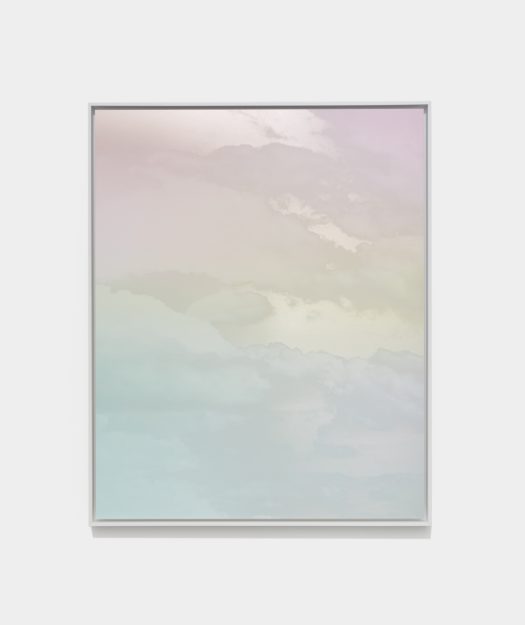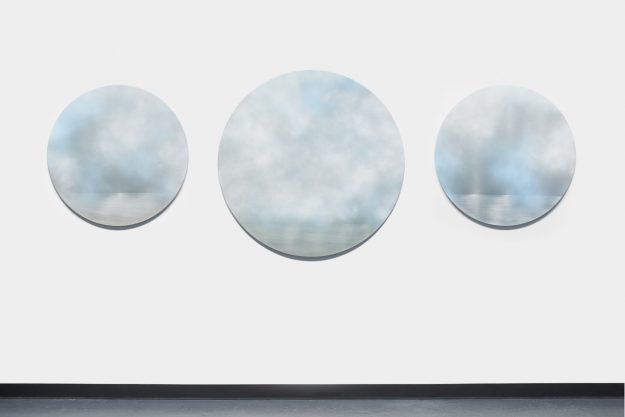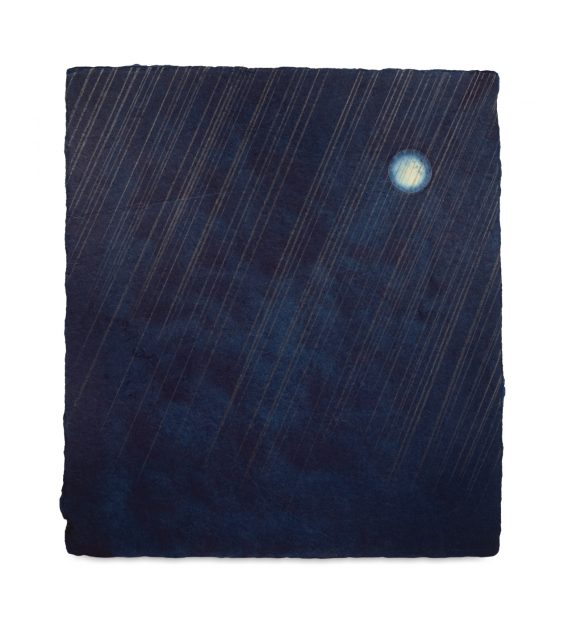“I’m interested in impermanence and time—that’s the main foundation of what I look at in my work,” multimedia artist Miya Ando says. “The work is conceptual, but it is highly informed by nature as a metaphor for the human condition and the passage of time.”
With subtle gradations of color appearing lit from within, Ando’s paintings depict the most ephemeral natural elements—clouds, mist, rain, the moon—with materials that are anything but. If it seems contradictory to convey impermanence on sheets of aluminum with micronized silver, Ando reminds us that metal is no more permanent than stars and fog: “The fundamental nature of reality is that all constituent forms that create the universe are ephemeral.”
Ando, who lives in New York City with her husband, artist Shelter Serra, works out of a studio in Long Island City. As with her paintings, her drawings, sculpture, and installations express “the Japanese aesthetic and philosophical concept of mono no aware—the pathos of things, often translated as an appreciation of particularly transitory things.”

Choosing metal as her medium was an outgrowth of coming to terms with her biracial, Japanese American identity. Born in Los Angeles, Ando spent her childhood shuttling between a Nichiren Buddhist temple in Okayama, Japan, where her maternal grandfather was head priest, and twenty-five acres of remote redwood forest in the Santa Cruz Mountains of California. She studied Japanese literature and Buddhist iconography as an undergraduate at UC, Berkeley, and a graduate student at Yale. But when she was invited to apprentice to a master metalsmith in Okayama—unheard of for a woman and someone of mixed race—she jumped at the chance to study metallurgy and explore her heritage.
“The work is conceptual, but it is highly informed by nature as a metaphor for the human condition and the passage of time.”
Ando is the fifteenth generation of swordsmiths turned Buddhist priests. When she saw the hamon—the cloudlike pattern along the blade edge—of a sword, “I had an epiphany,” she says. “Those clouds on the edge of this very sharp sword that was meant to kill you expressed something so poignantly and simply about the impermanence of life. It changed the course of my career.”
Returning to California in 1998, Ando began the cloud paintings she calls “the genesis of all my work.” The bilingual titles, like Hamon (A Cloud-like Pattern On The Edge Of A Sword) Morning Mist, are a nod to her dual heritage and interest in language. Phenomena 4.6 is a rare exception to her naming convention. The painting portrays a fog with droplets of moisture refracting light—a phenomenon “hard to describe,” Ando says. “Some things are just wondrous.”
Since her first show, in California in 1999, Ando’s work has been in dozens of solo and group shows, and is in museums and private collections worldwide. Her public commissions range from Winter Dawn Clouds, a four-inch glass cube for the Philip Johnson Glass House in New Canaan, Connecticut, to her only commission using existing metal, a 9/11 memorial, now in London’s Olympic Park, made from a three-story-high piece of twisted steel from the World Trade Center.


Ando doesn’t consider her work Buddhist art, but she brings a Zen sensibility to what she does. For Brookfield Place, a soaring space in lower Manhattan, she created a Flower Atlas Calendar, based on an ancient Japanese calendar divided into seventy-two seasons. “Flower time is just an alternative view of looking at time and calendrical systems through the lens of nature to counter some of the cultural and language loss,” Ando says. “These ancient systems can be an invitation to become more aware of the climate crisis through a poetic lens.”
“The fundamental nature of reality is that all constituent forms that create the universe are ephemeral.”
During the COVID pandemic, she worked on a more intimate scale, with aizome, traditional Japanese indigo dyeing. She drew the sky with moon and stars, compiling a dictionary of one thousand moon-related words in the process.
A similar exercise led to her current exhibit, “Miya Ando: Blue Sky Codex,” at the Sundaram Tagore Gallery in New York (October 24 to December 14, 2024). The twenty-four paintings are based on photographs taken over the past decade. Finding a paucity of English words to describe blue, she looked to a richer Japanese vocabulary for the 210 shades in “Blue Sky Codex” (Aotenjo Nikki), a bilingual visual dictionary.
Next autumn, MIT Press will publish Water of the Sky, Ando’s visual dictionary of two thousand Japanese rain words with English translations. Tsukimizutsuki (May, The Month That Rain Makes the Moon Invisible), is one of one hundred indigo and micronized silver images in the printed book. (The rest will be online.)

Thank you for subscribing to Tricycle! As a nonprofit, we depend on readers like you to keep Buddhist teachings and practices widely available.
